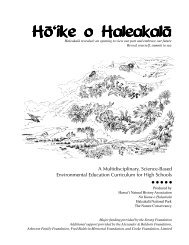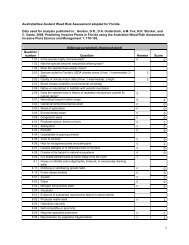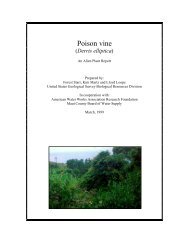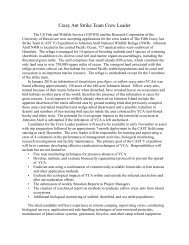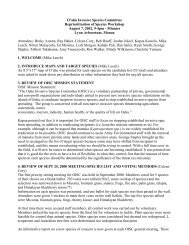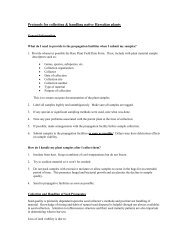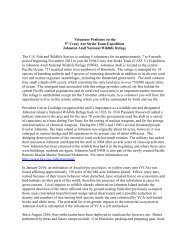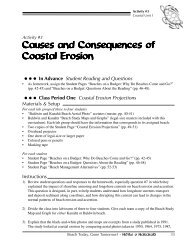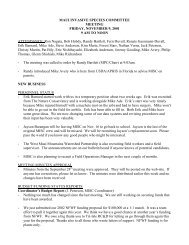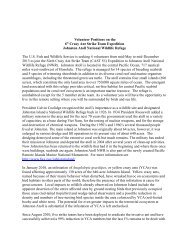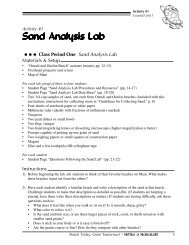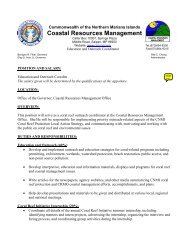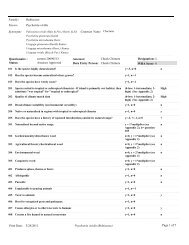Report to the Republic of Palau: 2008 update on Invasive Plant ...
Report to the Republic of Palau: 2008 update on Invasive Plant ...
Report to the Republic of Palau: 2008 update on Invasive Plant ...
Create successful ePaper yourself
Turn your PDF publications into a flip-book with our unique Google optimized e-Paper software.
a<str<strong>on</strong>g>the</str<strong>on</strong>g>r widespread in Hawai‘i <strong>on</strong> <str<strong>on</strong>g>the</str<strong>on</strong>g> island <str<strong>on</strong>g>of</str<strong>on</strong>g> Kauai. There it is spreading al<strong>on</strong>g roadsides, in<br />
hedges and invading sec<strong>on</strong>dary forest. It seems <str<strong>on</strong>g>to</str<strong>on</strong>g> have <str<strong>on</strong>g>the</str<strong>on</strong>g> ability <str<strong>on</strong>g>to</str<strong>on</strong>g> withstand herbicide<br />
treatments used <str<strong>on</strong>g>to</str<strong>on</strong>g> c<strong>on</strong>trol vegetati<strong>on</strong> al<strong>on</strong>g roads. The seeds are bird-dispersed, and it can also<br />
spread vegetatively through root tubers from discarded plants, am<strong>on</strong>g o<str<strong>on</strong>g>the</str<strong>on</strong>g>r characteristics giving<br />
it a “high risk” weed risk assessment score <str<strong>on</strong>g>of</str<strong>on</strong>g> 15. On several islands in T<strong>on</strong>ga, <str<strong>on</strong>g>the</str<strong>on</strong>g> thorny vines<br />
<str<strong>on</strong>g>of</str<strong>on</strong>g> a closely related species, Asparagus setaceus (not found in <str<strong>on</strong>g>Palau</str<strong>on</strong>g>), have become established in<br />
<str<strong>on</strong>g>the</str<strong>on</strong>g> forest unders<str<strong>on</strong>g>to</str<strong>on</strong>g>ry, climbing in<str<strong>on</strong>g>to</str<strong>on</strong>g> <str<strong>on</strong>g>the</str<strong>on</strong>g> canopy. Both species are comm<strong>on</strong>ly sold as ornamentals.<br />
What are probably <str<strong>on</strong>g>the</str<strong>on</strong>g> remnants <str<strong>on</strong>g>of</str<strong>on</strong>g> an old rattan (Calamus sp.) (bangerenguis ra ngebard)<br />
plantati<strong>on</strong> is present in Aimeliik State, Babeldaob. Not <strong>on</strong>ly is this species invasive, but its<br />
spine-armed stems and pairs <str<strong>on</strong>g>of</str<strong>on</strong>g> hooked flagellae extending from <str<strong>on</strong>g>the</str<strong>on</strong>g> leaves make travel where it<br />
is present difficult and painful.<br />
Cinnamomum verum [=C. zeylanicum] (ochod ra ngebard, cinnam<strong>on</strong>) was reported present by<br />
Fosberg et al. (1979) but was not seen in <str<strong>on</strong>g>the</str<strong>on</strong>g> previous or present survey or in <str<strong>on</strong>g>the</str<strong>on</strong>g> botanical<br />
survey <str<strong>on</strong>g>of</str<strong>on</strong>g> <str<strong>on</strong>g>the</str<strong>on</strong>g> Compact Road (Raulers<strong>on</strong> et al., 1996). If present, this is a potentially dangerous<br />
species. It is actively invading sec<strong>on</strong>dary forests in American Samoa and Samoa. It is also<br />
present and invasive in <str<strong>on</strong>g>the</str<strong>on</strong>g> Cook Islands (Raro<str<strong>on</strong>g>to</str<strong>on</strong>g>nga), Fiji, French Polynesia, Hawai‘i and<br />
Mauritius. Its weed risk assessment score <str<strong>on</strong>g>of</str<strong>on</strong>g> 10, although rating “high risk” may not fully reflect<br />
its invasiveness and potential for damage based <strong>on</strong> observed behavior elsewhere in <str<strong>on</strong>g>the</str<strong>on</strong>g> Pacific<br />
regi<strong>on</strong>.<br />
Cyperus involucratus [=C. alternifolius subsp. flabelliformis] (deus, umbrella sedge) was seen in<br />
cultivati<strong>on</strong> at <strong>on</strong>e locati<strong>on</strong> in Koror in <str<strong>on</strong>g>the</str<strong>on</strong>g> 2002 survey. While no examples were seen in this<br />
survey it is likely <str<strong>on</strong>g>to</str<strong>on</strong>g> still be present as it is <str<strong>on</strong>g>of</str<strong>on</strong>g>ten planted as an ornamental. It has a weed risk<br />
assessment score <str<strong>on</strong>g>of</str<strong>on</strong>g> 17 “high risk” and can be an invader in wet areas, especially al<strong>on</strong>g streams<br />
and rivers.<br />
Datura metel (downy thorn-apple, jims<strong>on</strong> weed), found <strong>on</strong> Ngercheu Island (Carp Resort), is a<br />
prolific seed producer that is naturalized and invasive in Hawai‘i, Fiji and Niue. It is also present<br />
<strong>on</strong> Angaur, Peleliu, Babeldaob and Malakal. A weed risk assessment from Australia gives this<br />
species a score <str<strong>on</strong>g>of</str<strong>on</strong>g> 21, making it high risk.<br />
Eichhornia crassipes (bung el ralm, water hyacinth) was seen in cultivati<strong>on</strong> <strong>on</strong> Koror,<br />
Ngerkebesang and Babeldaob in <str<strong>on</strong>g>the</str<strong>on</strong>g> 2002 survey. Water hyacinth is a well-known problem<br />
worldwide in freshwater lakes, p<strong>on</strong>ds, marshes, ditches, canals and slow-moving streams. It<br />
reproduces both by seed and vegetatively. Its weed risk assessment score <str<strong>on</strong>g>of</str<strong>on</strong>g> 14 makes it <str<strong>on</strong>g>of</str<strong>on</strong>g> high<br />
risk.<br />
Elaeocarpus angustifolius [=E. grandis] (blue fig, blue marble tree, quand<strong>on</strong>g), a native <str<strong>on</strong>g>of</str<strong>on</strong>g><br />
Australia, is a forestry tree that is invading intact and sec<strong>on</strong>dary forests in Samoa. It is reported<br />
present in <str<strong>on</strong>g>Palau</str<strong>on</strong>g> (Fosberg et al., 1979), perhaps in old forestry trials <strong>on</strong> Babeldaob, but was not<br />
seen <strong>on</strong> this or <str<strong>on</strong>g>the</str<strong>on</strong>g> 2002 survey.<br />
Epipremnum pinnatum ‘Aureum’ [=Scindapsus aureus] (pothos, m<strong>on</strong>ey plant) is present at a<br />
number <str<strong>on</strong>g>of</str<strong>on</strong>g> locati<strong>on</strong>s throughout <str<strong>on</strong>g>Palau</str<strong>on</strong>g> but most comm<strong>on</strong> in Koror and Airai States, including a<br />
patch invading Rock Island forest behind <str<strong>on</strong>g>the</str<strong>on</strong>g> <str<strong>on</strong>g>of</str<strong>on</strong>g>fice <str<strong>on</strong>g>of</str<strong>on</strong>g> The Nature C<strong>on</strong>servancy. It is mostly in<br />
14



